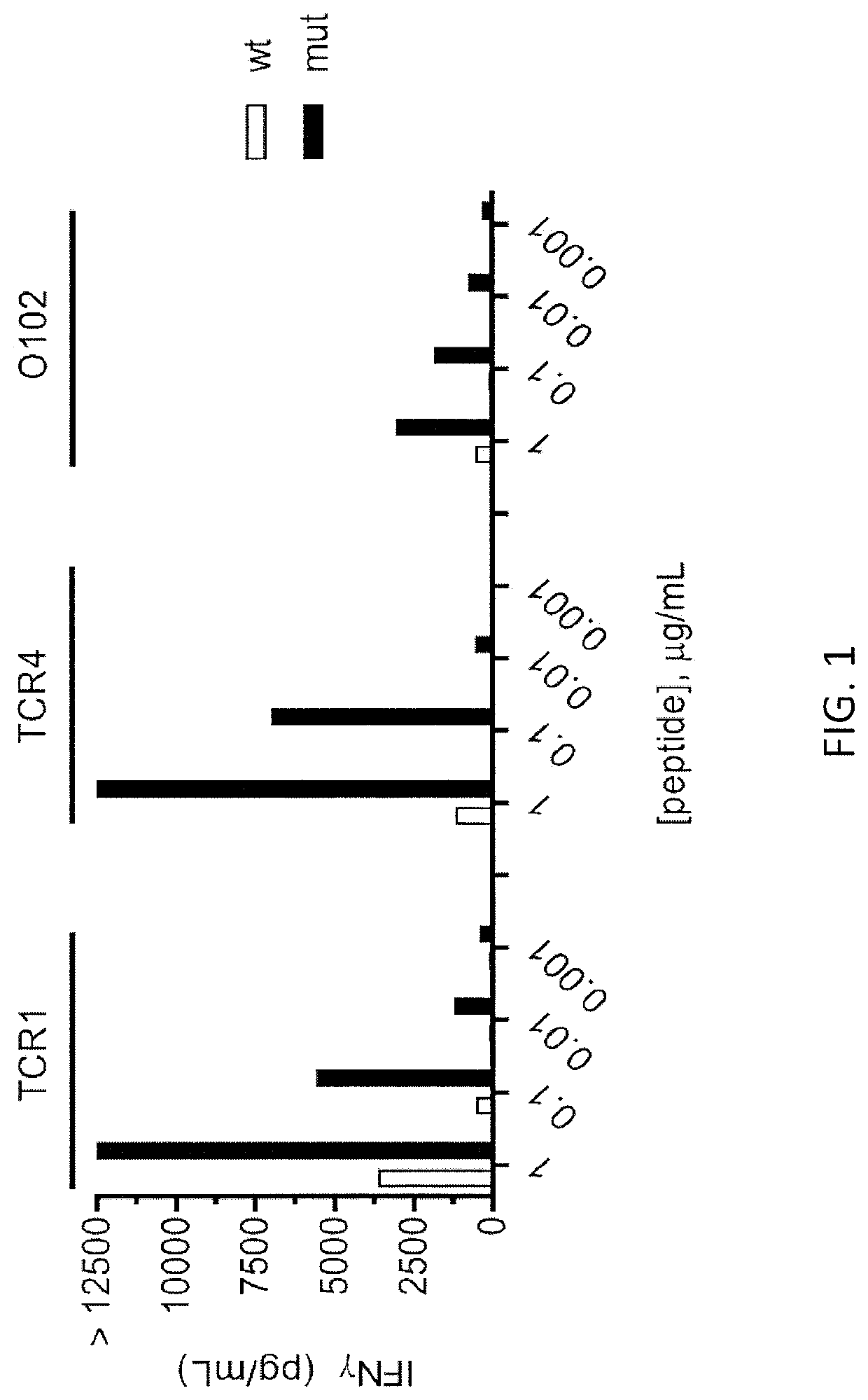T cell receptors recognizing mutated p53
a t cell receptor and mutated p53 technology, applied in the field of isolated or purified t cell receptors, can solve the problems of poor prognosis of many cancers, limited treatment options for cancers, and poor prognosis for many cancers, such as pancreatic, colorectal, ovarian, prostate cancer,
- Summary
- Abstract
- Description
- Claims
- Application Information
AI Technical Summary
Benefits of technology
Problems solved by technology
Method used
Image
Examples
example 1
[0150]This example demonstrates the isolation and specific reactivity of four anti-mutated p53 TCRs from patient 4127.
[0151]Experiments were carried out as described for FIGS. 1-7, 36, and 37A-37C for Patient 4127. The mutated p53 reactive T cells for this patient were identified by the method described in U.S. Patent Application Number 2017 / 0224800 (“Tran method”). The methods for isolating the individual TCRs are set forth below.
[0152]Autologous PBL were transduced with one of the TCRs shown in FIG. 1 and were tested 2 weeks later. Autologous DC cells were plated at 3×104 cells / well and pulsed overnight with either WT p53-G245 peptide (wt) or mutated p53-G245S peptide (mut) at decreasing peptide concentrations. 3×104 transduced T cells were added per well and co-cultured overnight at 37° C. Supernatants were harvested for IFN-γ ELISA. The IFN-γ ELISA results are shown in FIG. 1. 4-1BB expression was measured by FACS gate: lymphocytes\PI(neg)CD3+\CD3+mTCR+\CD8(neg)CD4+. The FACS re...
example 2
[0171]This example demonstrates the isolation and specific reactivity of three anti-mutated p53 TCRs from patient 4196.
[0172]Experiments were carried out as described for FIGS. 8-11 for Patient 4196. The p53 reactive T cells for this patient were identified by the Tran method, as described in U.S. Patent Application Number 2017 / 0224800. The Fluidigm method was used for isolating the individual TCRs. The statistics for Patient 4196 are shown in Table D.
[0173]Characterization of p53-reactive cells: challenges with identifying the minimal epitope: The first predicted peptide with mutated amino acid p53 R175H is shown in Table C.
TABLE CHLAHLA-A0201PeptideHMTEVVRHC (SEQ ID NO: 530)CoreHMTEVVRHC (SEQ ID NO: 530)Affinity (nM)7826.06% rank13.00
[0174]TMG1 versus 4196-Rx1 TIL: Cos7 cells were transfected with plasmids for TMG1 and HLA allele. Cells were co-cultured with 4196 Rx1 TIL infusion bag for 20 hours (h). The results are shown in FIG. 8A.
[0175]P53-R175H minimal peptide versus 4196-Rx1...
example 3
[0190]This example demonstrates the isolation of eleven anti-mutated p53 TCRs from patient 4238.
[0191]Experiments were carried out as described for FIGS. 12-15 for Patient 4238.
[0192]TIL fragments (F1-F24, n=24) from patient 4238 were co-cultured with autologous APCs electroporated with TMG composed of the irrelevant or mutated p53 sequence. Co-cultures were performed overnight at 37° C. Secretion of IFN-γ was evaluated using ELISPOT assay. The results are shown in FIG. 12. Expression of 4-1BB was evaluated by flow cytometry after gating for lymphocytes→living cells (PI negative)→CD3+ (T cells). The results are shown in FIG. 14.
[0193]TIL fragments (F1-F24, n=24) from patient 4238 were co-cultured with autologous APCs pulsed with peptide vehicle (DMSO) or purified (>95% by HPLC) 25-amino acid peptide composed of the mutated p53-R248Q sequence. Co-cultures were performed overnight at 37° C. Secretion of IFN-γ was evaluated using ELISPOT assay. The results are shown in FIG. 13. Express...
PUM
| Property | Measurement | Unit |
|---|---|---|
| Volume | aaaaa | aaaaa |
| Molar density | aaaaa | aaaaa |
| Molar density | aaaaa | aaaaa |
Abstract
Description
Claims
Application Information
 Login to View More
Login to View More - R&D
- Intellectual Property
- Life Sciences
- Materials
- Tech Scout
- Unparalleled Data Quality
- Higher Quality Content
- 60% Fewer Hallucinations
Browse by: Latest US Patents, China's latest patents, Technical Efficacy Thesaurus, Application Domain, Technology Topic, Popular Technical Reports.
© 2025 PatSnap. All rights reserved.Legal|Privacy policy|Modern Slavery Act Transparency Statement|Sitemap|About US| Contact US: help@patsnap.com



